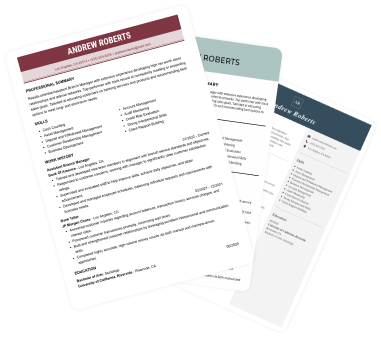
How to Write a Letter of Application That Works
Make your job application letter shine! Follow our letter of application template and examples for a polished, professional submission.
November 17, 2025
Last updated on 7 November, 2025
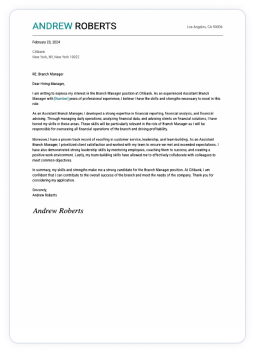
Having a great research assistant cover letter is like designing a well-structured study. It adds clarity, depth, and purpose to your application. And while your CV outlines the data, your cover letter connects the dots, making a convincing case for why you're the right fit for the role.
Whether you’re performing experiments in the lab, gathering anthropological data, or testing the limits of your computer's open browser tabs before it crashes, this guide is for you. So let me tell you all about writing a research assistant cover letter!
This guide will show you:
Use the LiveCareer cover letter builder and your cover letter will write itself. Choose a professional template, answer a few easy questions and the creator will generate a professional cover letter for you with just one click.
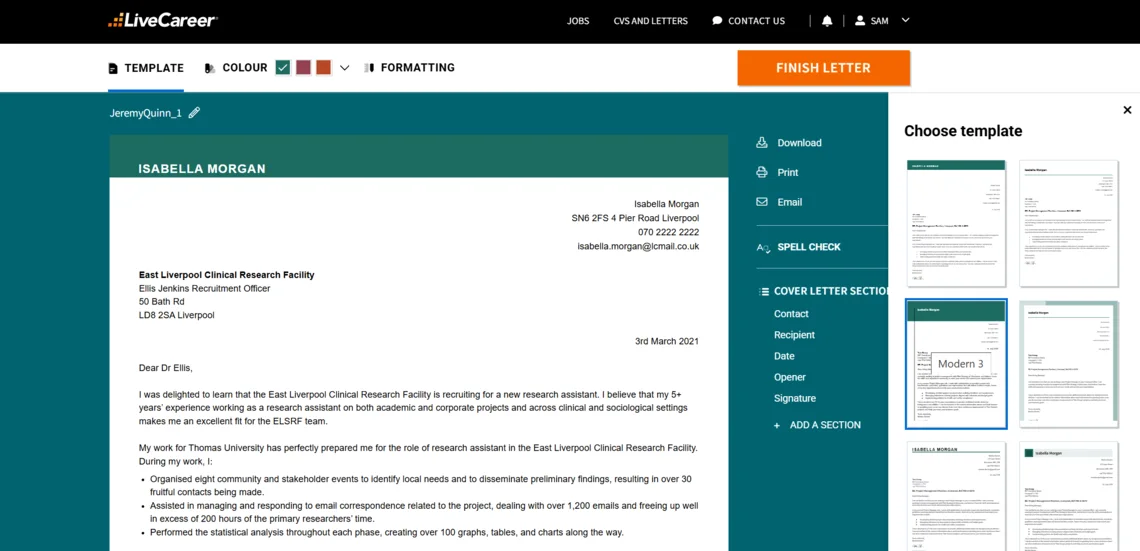
Isabella Morgan
4 Pier Road
Liverpool
SN6 2FS
070 2222 2222
isabella.morgan@lcmail.co.uk
3rd March 2021
Ellis Jenkins
Recruitment Officer
East Liverpool Clinical Research Facility
50 Bath Rd
Liverpool
LD8 2SA
Dear Dr Ellis,
I was delighted to learn that the East Liverpool Clinical Research Facility is recruiting for a new research assistant. I believe that my 5+ years’ experience working as a research assistant on both academic and corporate projects and across clinical and sociological settings makes me an excellent fit for the ELSRF team.
My work for Thomas University has perfectly prepared me for the role of research assistant in the East Liverpool Clinical Research Facility. During my work, I:
As you can see, my background as a clinical research assistant has equipped me well to handle the strictly scientific and mathematical aspects of my job, whereas my interpersonal and communication skills enable me to excel in the more sociological aspects.
Thank you for taking the time to consider my application. I look forward to discussing with you how I can help ELSRF in the experimental design and execution phases of the Reeves project.
Yours sincerely,
Isabella Morgan
P.S. I’d love to share about when I analysed over 1 GB of data and wrote three reports on secondary findings from the project; two were reworked into grant applications worth over £400,000. The unique approach I took would be even more effective for the East Liverpool Clinical Research Facility.
A research assistant cover letter is a concise document, typically one page long, submitted alongside the CV. It helps you introduce yourself, outline qualifications, and explain motivation for applying. It also shows that you’re not afraid to put in extra work if it might yield better results.
For a research assistant role, a cover letter should convey an understanding of the responsibilities, such as data collection, analysis, and supporting research operations. It should also demonstrate how the applicant’s work achievements have prepared them to add value to the new company. After all, that’s what a cover letter should do: answer the needs of the second party.
Now that we know what a cover letter is, let’s find out why it is necessary for all research assistants.
Adding a cover letter to your application is essential because it demonstrates that you’ve done your homework, not just about the role but also about the organisation itself. A targeted cover letter demonstrates your understanding of the research focus, grasp of the position's requirements, and readiness to make meaningful contributions. It also showcases your communication skills, which are crucial when drafting reports, presenting findings, or collaborating on publications.
Research assistant roles often support principal investigators or larger research teams. Employers seek candidates who blend technical expertise with qualities such as precision, organisation, teamwork, and initiative. Including a tailored cover letter alongside your CV shows you’re serious, thorough, and willing to go the extra mile, just as in any good research project.
Now it’s time to see how to write an impressive research assistant cover letter:
Just as properly labelling a dataset ensures clarity and credibility in research, clearly formatting your contact details establishes a professional tone for your application. This section serves as your identifier, so it must be accurate, neat, and easy to read.
Here’s how to create a research assistant cover letter header:
Let’s see an example of how to address a cover letter:
Isabella Morgan
4 Pier Road
Liverpool
SN6 2FS
070 2222 2222
isabella.morgan@lcmail.co.uk
3rd March 2021
Ellis Jenkins
Recruitment Officer
East Liverpool Clinical Research Facility
50 Bath Rd
Liverpool
LD8 2SA
A personal approach often unlocks better data. The same is true for applications. Addressing your letter to the right person builds early rapport and shows that you’ve done some groundwork. Not to mention the power of personalising your document from the very first words.
Here’s how to write a research assistant cover letter salutation:
See how simple it is:
Dear Dr Ellis,
You can adjust every cover letter created in the builder to meet the job requirements. Choose the name of your profession and the company to which you’re applying, and the LiveCareer cover letter builder will automatically adapt the content for you. Create a cover letter faster than you ever thought possible and apply for the job in record time.
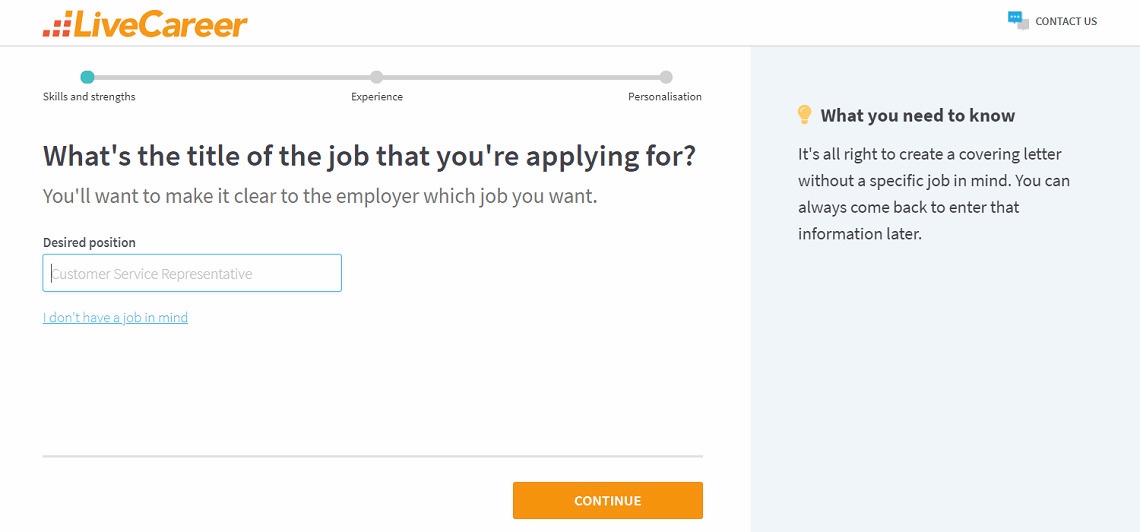
An abstract in a research paper immediately grabs attention. Your cover letter intro should do the same. This is your chance to present your core thesis: why you're the right person for this role.
Here’s how to start a cover letter for a research assistant position:
Let’s see an example of how to do it right:
I was delighted to learn that the East Liverpool Clinical Research Facility is recruiting for a new research assistant. I believe that my 5+ years’ experience working as a research assistant on both academic and corporate projects and across clinical and sociological settings makes me an excellent fit for the ELSRF team.
This section presents your findings and analysis, demonstrating your value with evidence. Utilise real-life experiences and specific skills that align with the role's demands to make sure you’re seen as not only an impressive but also a well-fitted candidate.
Here’s how to write an excellent middle part of your research assistant cover letter:
And here’s how it’s done:
My work for Thomas University has perfectly prepared me for the role of research assistant in the East Liverpool Clinical Research Facility. During my work, I:
As you can see, my background as a clinical research assistant has equipped me well to handle the strictly scientific and mathematical aspects of my job, whereas my interpersonal and communication skills enable me to excel in the more sociological aspects.
A reasonable conclusion ties your findings back to the research question. Your final paragraph should connect your experience to the role’s objectives. Reinforce your interest and prompt action to leave the reader with a great impression of your candidacy. Just like signing off on lab notes or field reports, your closing should be neat, appropriate, and leave no room for ambiguity.
Here’s how to write an excellent ending of a cover letter for a research assistant:
See an example of how to end a cover letter well:
Thank you for taking the time to consider my application. I look forward to discussing with you how I can help ELSRF in the experimental design and execution phases of the Reeves project.
Yours sincerely,
Isabella Morgan
In research, the appendix sometimes holds the most surprising insights. A postscript (P.S.) in your cover letter can do the same. It’s a clever, optional addition that draws the reader’s eye and gives you one final chance to make a lasting impression.
Here’s how to add a postscript to your cover letter:.
See an example of the right postscript:
P.S. I’d love to share about when I analysed over 1 GB of data and wrote three reports on secondary findings from the project; two were reworked into grant applications worth over £400,000. The unique approach I took would be even more effective for the East Liverpool Clinical Research Facility.
A well-written cover letter can help you stand out from other applicants. Use these simple tips to keep your letter relevant, persuasive, well-structured, and easy to read.
Below is your checklist for quality control. Use it before sending out your research assistant cover letter:
Considering other positions too? See cover letter examples for different jobs:
Want to explore other options? See our selection of cover letter examples for other jobs.
You don’t have to create any content yourself. The LiveCareer cover letter generator will automatically suggest the best content for your cover letter with ready-made examples and expert tips.
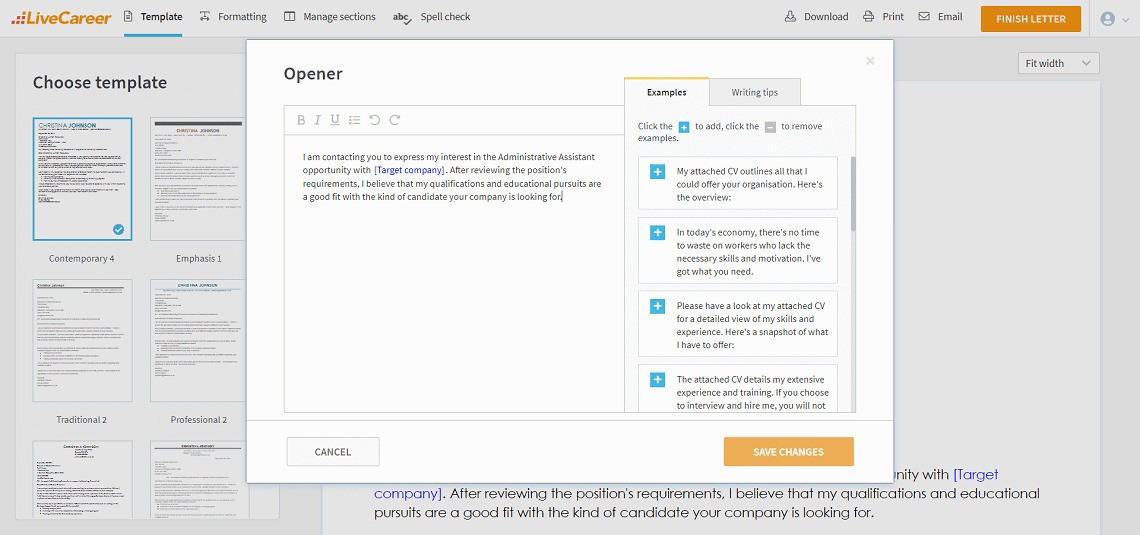
And that’s it. Now you know everything there is to know about writing an interview-worthy, job-winning, well-researched research assistant cover letter. Just remember: a thoughtful cover letter not only showcases suitability for the role but also reflects your research skills and professional approach. Good luck!
Our editorial team has reviewed this article for compliance with LiveCareer’s editorial guidelines. It’s to ensure that our expert advice and recommendations are consistent across all our career guides and align with current CV and cover letter writing standards and trends. We’re trusted by over 10 million job seekers, supporting them on their way to finding their dream job. Each article is preceded by research and scrutiny to ensure our content responds to current market trends and demand.
Category: Cover Letter Examples
Crafting a job-winning CV is all about showcasing your unique skills and experiences. Start with a strong personal statement that highlights your career goals and achievements.
Try Our CV Builder Now